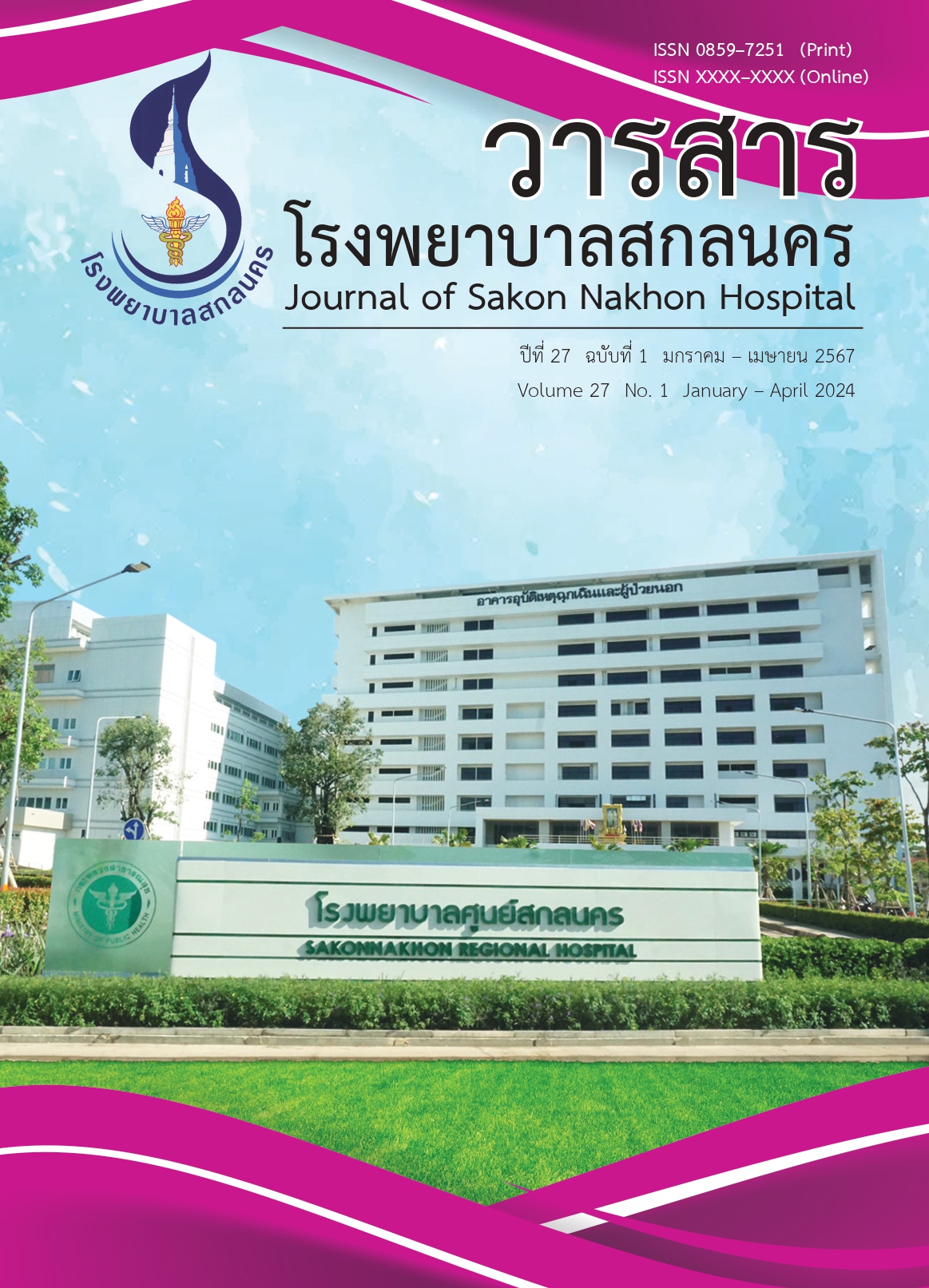ศึกษาปัจจัยที่มีผลต่อการเปลี่ยนแปลงของน้ำหนักตัวก่อนและหลังการรักษา ในผู้ป่วยไทรอยด์เป็นพิษ
คำสำคัญ:
ภาวะต่อมไทรอยด์ทำงานเกิน, ไทรอยด์เป็นพิษ, อ้วน, ดัชนีมวลกายบทคัดย่อ
ภาวะไทรอยด์เป็นพิษส่งผลให้น้ำหนักลดลง ซึ่งพบได้บ่อย แต่ไม่ใช่ผู้ป่วยไทรอยด์เป็นพิษทั้งหมดที่มีนน้ำหนักตัวลดลง จากการศึกษาที่ผ่านมาพบว่า มีผู้ป่วยร้อยละ 5 – 10 มีน้ำหนักตัวเพิ่มขึ้นตั้งแต่ก่อนได้รับการรักษา การศึกษานี้ต้องการศึกษาปัจจัยที่มีผลต่อการเปลี่ยนแปลงน้ำหนักตัวของผู้ป่วยก่อนและหลังได้รับการรักษา โดยศึกษาชนิดย้อนหลังในผู้ป่วยไทรอยด์เป็นพิษที่มารับการรักษาที่โรงพยาบาลพุทธโสธร ลงรหัสวินิจฉัยโรค E05 ถึง E07 ตั้งแต่ 1 มิถุนายน
พ.ศ. 2561 ถึง 30 กันยายน พ.ศ. 2565 วิเคราะห์ข้อมูลโดยใช้สถิติ Chi–square, Student’s t–test และ logistic regression analysis
ผู้ป่วยจากการศึกษานี้จำนวน 233 คน มีน้ำหนักเมื่อเริ่มต้นรักษาเฉลี่ย 60.44 ± 0.79 กิโลกรัม ดัชนีมวลกายเมื่อเริ่มรักษาเฉลี่ย 23.58 ± 0.28 กิโลกรัม/เมตร2 ซึ่งอยู่ในกลุ่มที่มีน้ำหนักตัวเกินเกณฑ์ตั้งแต่แรกและมีน้ำหนักตัวเพิ่มขึ้นเมื่อสิ้นสุดการรักษา โดยจะเพิ่มขึ้นมากในกลุ่มดัชนีมวลกายน้อย ปัจจัยที่มีผลต่อการเพิ่มของดัชนีมวลกาย คือ ผู้ป่วยที่
อายุน้อยกว่า 45 ปีเมื่อเริ่มรักษา (p = 0.0399) ดัชนีมวลกายที่น้อยกว่า 25 กิโลกรัม/เมตร2 เมื่อเริ่มต้นรักษา (p = 0.0193) ผู้ป่วยที่เกิดไทรอยด์ต่ำหลังการรักษามีดัชนีมวลกายที่เพิ่มขึ้นมากกว่าผู้ป่วยไม่เกิดไทรอยด์ต่ำ(p = 0.0069) เมื่อวิเคราะห์โดยใช้logistic regression analysis พบว่า ผู้ป่วยไทรอยด์เป็นพิษชนิด Graves’ disease มีการเพิ่มขึ้นของน้ำหนักตัวและดัชนีมวลกายมากกว่าไทรอยด์เป็นพิษชนิดอื่น (p = 0.0193 และ p = 0.016 ตามลำดับ) จากการศึกษาจะช่วยนำมาเป็นแนวทางในการเฝ้าระวัง ติดตาม ปรับเปลี่ยนพฤติกรรมในการบริโภคเพื่อไม่ให้เกิดภาวะอ้วนหลัง
การรักษาไทรอยด์เป็นพิษ
References
Bahn RS, Burch HB, Cooper DS, Garber JR, Greenlee MC, Klein I, et al. Hyperthyroidism and other causes of thyrotoxicosis: Management guidelines of the American thyroid association and American association of clinical endocrinologists. Endocr Pract 2011;17(3):456–520.
Terry F, Davies PL, Bahn RS, Melmed S, Polonsky KS, Larsen PR. Hyperthyroid disorders. In: William Textbook of Endocrinology. Kronenberg HM; Philadelphia, PA: Elsevier; 2016; p. 369–415.
Smith TJ, Hegedüs L. Graves’ disease. N Engl J Med 2016;375(16):1552–65.
Lewis E, Braverman D. Werner and Ingbar’s The Thyroid a Fundamental and Clinical Text. Lippincott Williams & Wilkins; 2013.
Snabboon T, Sridama V, Sunthornyothin S, Suwanwalaikorn S, Vongthavaravat V. A more appropriatealgorithm of thyroidfunction test in diagnosisof hyperthyroidism for Thaipatients. J Med Assoc Thai 2004;87(Suppl2):S19–21.
Shigemasa C, Abe K, TaniguchiS, Mitani Y, Ueda Y, Adachi T.Lower serum freethyroxine(T4) levels in painless thyroiditis compared with Graves’ disease despite similar serum total T4 levels. J Clin Enocrinol 1987;65(2):359–63.
Sriphrapradang C, Bhasipol A. Differentiating Graves’disease from subacute thyroiditisusing ratio of rerum free triiodothyronine to free thyroxine. Ann Med Surg (Lond) 2016;10:69–72.
The Western Pacific Region. World Health Organization. International Associates for the study of obesity. International Obesity Task Force. The Asia–Pacific Perspective: redefining obesity and its treatment. Melbourne: Health Communications Australia; 2000.
Lung B. Clinical guidelines on the identification, evaluation and treatment of overweight and obesity in adults. Bethesda, MD: US Department of Health and Human Services; 1998.
CrookJ, MurrayPC, Wayne EJ.Statistical methodsappliedtothediagnosisof thyrotoxicosis. Quarterly Journal of Medicine 1959;28(110):211–34.
Garney C, Hall R, Harper M, Owen SG, Roth M, Smart GA. Newcastle thyrotoxicosis index. Lancet 1970;2(7686):1275–8.
Rathi MS, Miles JN, Jennings PE. Weight gain during the treatment of thyrotoxicosis using conventional thyrostatic treatment. J Endocrinol Invest 2008;31:505–8.
Franklyn JA, Daykin J, Drolc Z, Farmer M, Sheppard MC. Long–term follow–up of treatment of thyrotoxicosis by three different methods. Clin Endocrinol (Oxf) 1991;34(1):71–6.
Dale J, Daykin J, Holder R, Sheppard MC, Franklyn JA. Weight gain following treatment of hyperthyroidism. Clin Endocrinol (Oxf) 2001;55:233–9.
Downloads
เผยแพร่แล้ว
How to Cite
ฉบับ
บท
License
บทความที่ตีพิมพ์ถือว่าเป็นลิขสิทธิ์ของวารสารโรงพยาบาลสกลนคร การคัดลอกเพื่อพัฒนาเชิงวิชาการต้องได้รับการอ้างอิงอย่างถูกต้อง





